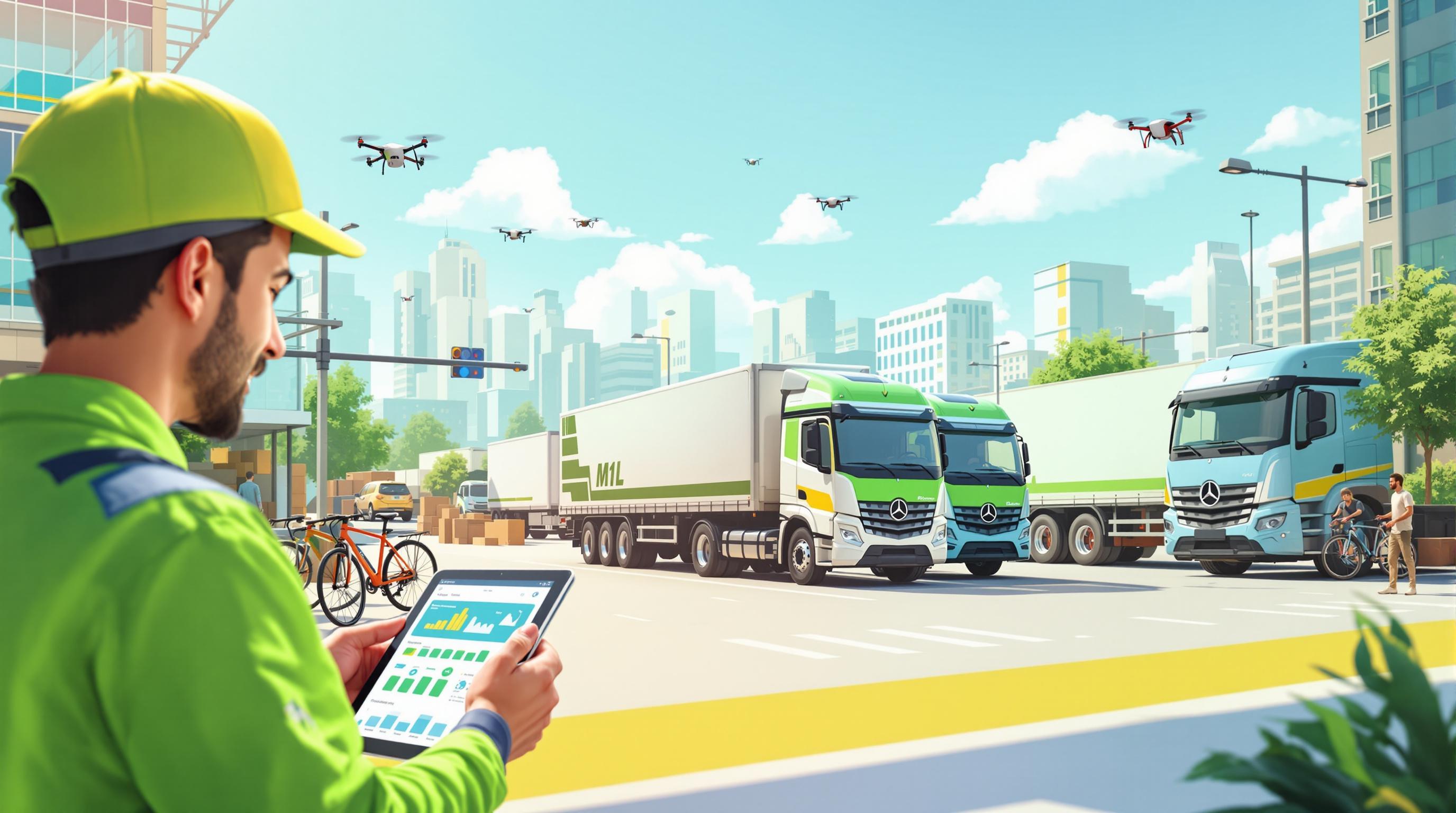Terrain directly impacts how efficiently routes can be planned and executed. Whether navigating steep mountain roads or busy city streets, understanding terrain challenges helps businesses save time, fuel, and resources. Here’s a quick breakdown:
- Mountain Routes: Steep inclines and winding roads slow vehicles, increase fuel use, and wear down brakes.
- Flat Terrain: Easier to drive but can cause driver fatigue on long stretches with fewer stops.
- City Streets: Traffic, one-way roads, and limited loading zones disrupt schedules.
- Rural Areas: Sparse roads and unpredictable conditions require careful planning.
Key Takeaways:
- AI tools like Routemize use terrain, elevation, and traffic data to optimize routes.
- Real-time updates adjust for weather, road closures, and traffic changes.
- Businesses can improve efficiency by analyzing terrain and setting clear route parameters.
Efficient routing starts with understanding your environment and leveraging AI-powered tools to adapt to terrain challenges.
Types of Terrain and Their Effects
Mountain Routes
Driving through mountains comes with its own set of challenges. Steep inclines lead to higher fuel consumption and put extra strain on the vehicle's engine and brakes. Tight turns and winding roads require slower speeds, adding to travel time. These conditions also wear down brake systems and transmissions faster. When planning a route through mountainous areas, it's crucial to account for these factors.
Flat Terrain
Flat roads may seem easier, but they come with their own issues. Long, uninterrupted stretches can lead to driver fatigue and lapses in focus. Additionally, the distance between fuel stations and rest stops can be significant, making it harder to plan for breaks. Road conditions can also vary widely, from smooth highways to rough, unpaved roads. To manage these challenges, plan for regular breaks and ensure vehicles are well-maintained.
City Streets
Urban driving presents a different set of hurdles. Traffic congestion, one-way streets, frequent construction, and limited loading zones can all disrupt schedules. To navigate city streets efficiently, stay updated on real-time traffic conditions and road closures. Scheduling deliveries or appointments during off-peak hours can also help avoid delays.
AI in Action: Solving the Last Mile Problem in Humanitarian Aid
U.S. Geographic Barriers
The United States presents a variety of geographic challenges that directly influence route planning. From vast water bodies to rugged terrain, these natural obstacles, combined with traffic patterns and rural infrastructure, play a major role in shaping routing strategies.
Water and Land Barriers
Large rivers and mountainous terrain often limit available routes. Rivers may have only a few crossing points, like bridges or ferries, while areas with steep or uneven landscapes might offer fewer road options. These factors require careful planning to find the most efficient paths.
City Traffic Patterns
Urban areas bring their own set of challenges. Traffic can shift quickly, especially during rush hours, causing delays. Dense city grids demand constant route adjustments based on real-time data to avoid bottlenecks. On the other hand, rural areas may lack connectivity, presenting a different kind of complexity.
Rural Road Challenges
In rural regions, sparse road networks and unpredictable conditions, like closures or weather disruptions, make route planning more complicated. Tools powered by AI, such as Routemize, can analyze real-time weather and road data to provide accurate travel estimates. These systems automatically adjust routes, helping drivers navigate obstacles more effectively.
Navigating these geographic challenges requires smart tools and strategies to ensure efficient travel across the U.S. landscape.
sbb-itb-7020db0
AI Solutions for Terrain Routing
AI systems now address terrain challenges by incorporating real-time geographic data. These advanced tools combine multiple data sources to account for varying terrain conditions.
Terrain Data Analysis
AI-powered route optimization platforms analyze multiple layers of terrain data at once to create effective routing models. These models process details such as:
- Elevation profiles: Highlighting height changes that impact travel
- Road characteristics: Including surface types, widths, and grade percentages
- Geographic features: Identifying natural barriers like rivers, mountains, and valleys
- Infrastructure data: Factoring in bridges, tunnels, and highway interchanges
For example, Routemize's AI system combines terrain data with real-time traffic updates to calculate routes that balance efficiency with road conditions. It evaluates elevation changes and road grades to identify practical paths, which is especially useful for delivery vehicles in hilly or mountainous regions.
This detailed terrain analysis helps define the key parameters for selecting the best routes.
Route Selection Factors
AI systems consider several important factors when determining the best routes through diverse terrain:
| Factor | Impact on Routing | AI Consideration |
|---|---|---|
| Elevation Changes | Affects vehicle performance and fuel use | Adjusts speed and energy estimates for inclines |
| Road Surface | Impacts travel speed and vehicle wear | Modifies time estimates based on surface conditions |
| Weather Effects | Alters road accessibility and safety | Integrates weather data into route planning |
| Traffic Density | Varies depending on terrain and location | Combines historical and real-time traffic information |
Live Route Updates
Building on terrain analysis and route selection, live updates ensure routes stay efficient. Modern routing systems continuously monitor:
- Weather impacts: Adjusting routes based on rain, snow, or reduced visibility
- Traffic patterns: Analyzing congestion trends across different terrains
- Road status: Tracking closures, construction, or other obstacles
Routemize's platform recalculates routes in real time by integrating live weather, traffic, and road condition data. This helps drivers avoid unexpected delays while maintaining efficient paths, even through challenging terrain.
Steps to Plan Better Routes
Create more efficient routes by combining detailed terrain data with real-time updates.
Data Collection
Gather key information such as:
- Elevation changes and road grades
- Road surface conditions
- Weather patterns
- Traffic history
This data powers Routemize's AI-driven routing algorithms. Once collected, define specific routing needs to make the most of this information.
Route Requirements
Set clear requirements so the AI can create routes tailored to both operational goals and terrain challenges:
- Provide vehicle dimensions and weight limits
- Outline delivery time windows based on terrain
- Specify cargo details and handling needs
- Highlight unique conditions like slope preferences
These details help align routing solutions with both the physical environment and business objectives.
Route Monitoring
Continuous route monitoring ensures better performance by adapting to real-time conditions. Keep track of routes by:
- Comparing actual and predicted travel times
- Adjusting for weather changes
- Evaluating fuel efficiency
Conclusion
Main Points
The combination of terrain data and AI-powered routing is changing how businesses handle operational planning. Terrain plays a major role in route efficiency across the U.S., with each type presenting unique challenges. Using AI for terrain analysis allows businesses to:
- Adjust routes dynamically to save time
- Respond instantly to weather and traffic changes
- Factor in vehicle capabilities based on terrain
- Maintain a balance between efficiency and operations
Next Steps
To improve your routing strategy, consider these steps:
-
Understand Your Operating Environment
- Analyze elevation changes in your service area
- Monitor how seasonal weather affects routes
- Study traffic patterns to identify problem areas
-
Set Up Route Parameters
- Input vehicle details and specifications
- Create delivery schedules based on terrain
- Prioritize deliveries based on operational needs
-
Track and Refine
- Measure performance across different terrains
- Compare actual delivery times to predictions
- Update routing settings based on performance insights
Use Routemize's AI platform to implement these steps and achieve real-time improvements. This approach helps tackle terrain-related challenges and streamlines delivery processes.
FAQs
How does AI, like Routemize, use terrain data to optimize routes?
AI-powered tools, such as Routemize, analyze various factors like terrain types - mountains, plains, or urban areas - to create the most efficient routes. By considering how terrain impacts travel speed and fuel usage, these systems adjust routes to save time and resources.
For example, steep mountain roads or dense urban areas with heavy traffic may require different strategies compared to open highways. AI adapts to these challenges in real time, ensuring drivers spend less time navigating obstacles and more time focusing on their tasks.
How can businesses help drivers stay alert on long, flat routes?
Driver fatigue can be a serious issue on long, flat routes where the monotony of the terrain may lead to reduced focus. To help drivers stay alert, businesses can implement a few key strategies:
- Schedule regular breaks: Encourage drivers to take short breaks every 2–3 hours to stretch, hydrate, and refresh.
- Promote healthy habits: Provide guidance on maintaining a balanced diet and getting enough sleep before long trips.
- Use technology for support: Tools like AI-driven route optimization can help reduce overall driving time and ensure more efficient routes, minimizing fatigue.
By prioritizing driver well-being, businesses can improve safety and efficiency on the road.
How do real-time updates enhance route optimization in areas with unpredictable conditions like rural roads or city traffic?
Real-time updates play a vital role in improving route efficiency, especially in areas where conditions can change unexpectedly, such as rural roads or busy urban streets. By continuously analyzing factors like traffic patterns, road closures, and appointment locations, AI-powered tools can quickly adapt routes to avoid delays.
This dynamic approach helps minimize travel time, ensuring you spend less time navigating challenges on the road and more time focusing on what matters - whether that's meeting clients or completing tasks efficiently.


